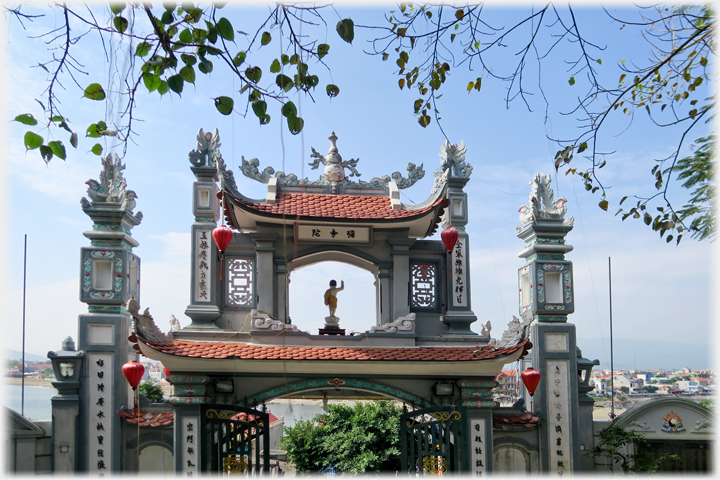 The Đót Tiên Pagoda is well protected from invasions of foreign visitors. It took me 10 years to discover this "Site of historic interest" and it is only six kms from our house. The excuse for such slowness is its location. The town of Hải Thanh is crammed into a peninsular formed between a river estuary and the sea which is some three to four hundred meters wide and two kilometres long. It ends in a bulge formed by a small hill on which sits the Đót Tiên Pagoda. The road that runs like a spine through the town narrows to a lane and...
The canopy over the entrance gate to the Đót Tiên Pagoda, the town of Hải Bình is across the river
The Đót Tiên Pagoda is well protected from invasions of foreign visitors. It took me 10 years to discover this "Site of historic interest" and it is only six kms from our house. The excuse for such slowness is its location. The town of Hải Thanh is crammed into a peninsular formed between a river estuary and the sea which is some three to four hundred meters wide and two kilometres long. It ends in a bulge formed by a small hill on which sits the Đót Tiên Pagoda. The road that runs like a spine through the town narrows to a lane and...
The canopy over the entrance gate to the Đót Tiên Pagoda, the town of Hải Bình is across the river
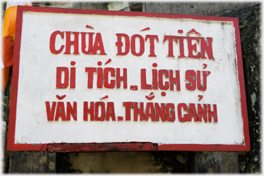 ...having reached the steps up to the pagoda, it is not wide enough for cars. Here deep in an unvisited community, where only Vietnamese is spoken or written, there is the large sign and steps which disappear up behind the houses. The main pagoda building lies up a couple of hundred steps and its grounds rise on up the hill to the flatter area on which statues of Buddhist sages stand. The views are rewarding, but should you discover the Đót Tiên Pagoda, wait for the winter before ascending, it is hot work.
The above sign might be translated: "Dot Tien Pagoda. Historic site of culture and beauty". Below: The sign is at the bottom of the steps to the pagoda; these rise on the left, while the lane goes on to the right
...having reached the steps up to the pagoda, it is not wide enough for cars. Here deep in an unvisited community, where only Vietnamese is spoken or written, there is the large sign and steps which disappear up behind the houses. The main pagoda building lies up a couple of hundred steps and its grounds rise on up the hill to the flatter area on which statues of Buddhist sages stand. The views are rewarding, but should you discover the Đót Tiên Pagoda, wait for the winter before ascending, it is hot work.
The above sign might be translated: "Dot Tien Pagoda. Historic site of culture and beauty". Below: The sign is at the bottom of the steps to the pagoda; these rise on the left, while the lane goes on to the right
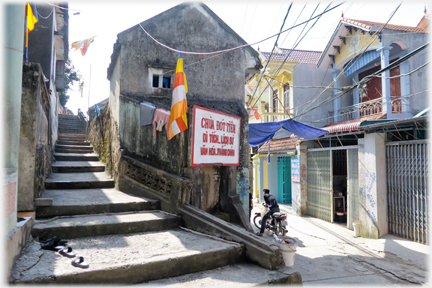
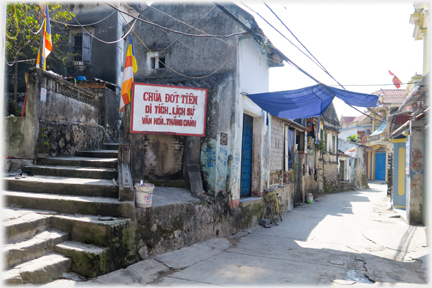
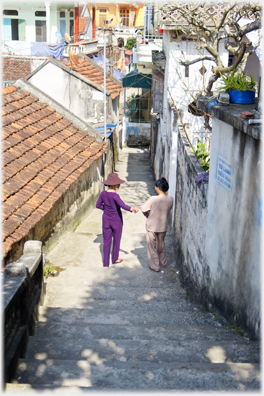 Looking back to the stair foot...
Looking back to the stair foot...
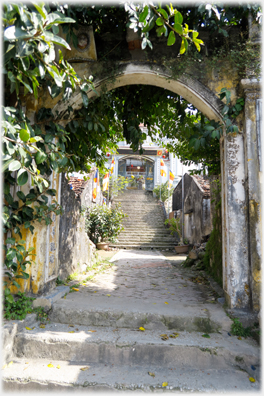 ...and looking ahead to the flights...
...and looking ahead to the flights...
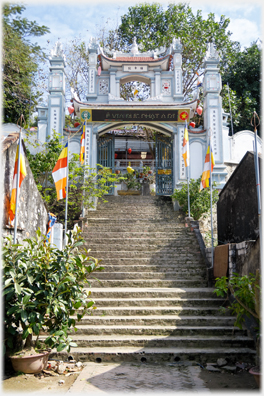 of steps. Above, the entrance gate
of steps. Above, the entrance gate
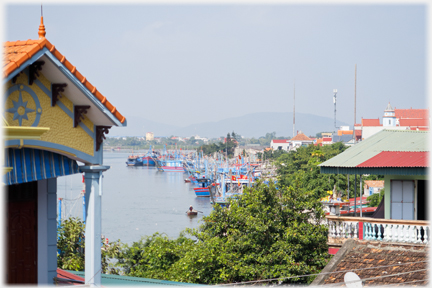 Climbing the hill, the need to stop and admire the view becomes imperative, fortunately the confluence of the Lạch Bạng and Kênh Than rivers below justifies a stop
Climbing the hill, the need to stop and admire the view becomes imperative, fortunately the confluence of the Lạch Bạng and Kênh Than rivers below justifies a stop
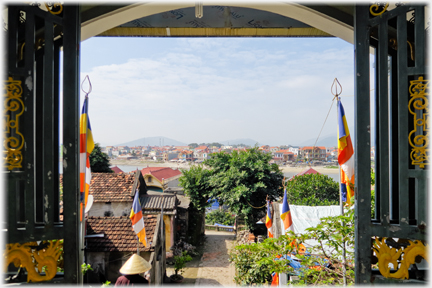 A stop which can be repeated at the top of the steps when turning and looking back down through the gates,
A stop which can be repeated at the top of the steps when turning and looking back down through the gates,
gives this view
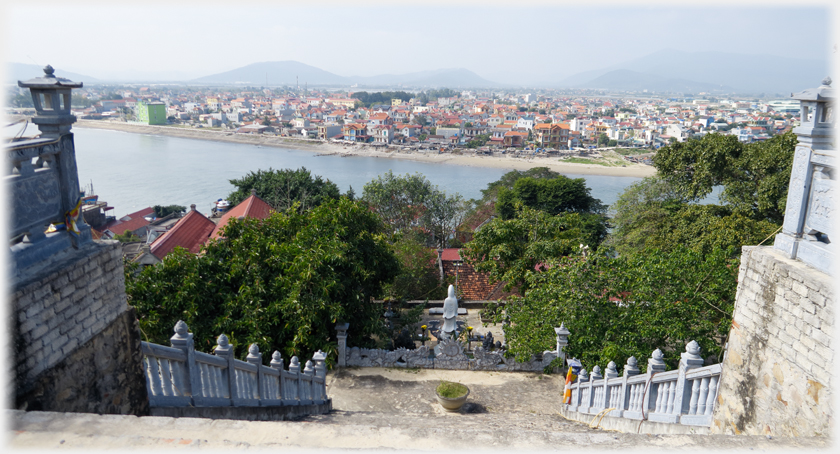 Having passed through the entrance gate and courtyard of the pagoda, the steps continue beyond, now in grand form. In the picture above the roof of the pagoda is directly beyond the standing figure at the bottom of the steps. Below: To the left is the same figure, but closer, and below centre much closer. The picture to the right is of the row of statues that are behind the photographer on the last shots, and stand on one side of a square
Having passed through the entrance gate and courtyard of the pagoda, the steps continue beyond, now in grand form. In the picture above the roof of the pagoda is directly beyond the standing figure at the bottom of the steps. Below: To the left is the same figure, but closer, and below centre much closer. The picture to the right is of the row of statues that are behind the photographer on the last shots, and stand on one side of a square
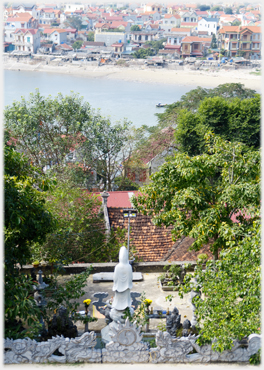
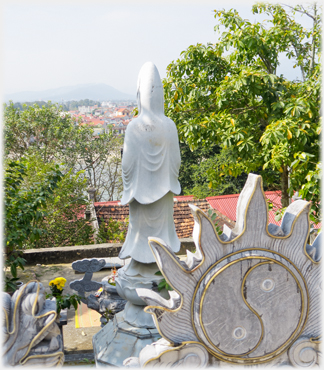
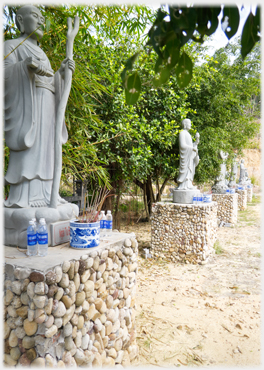
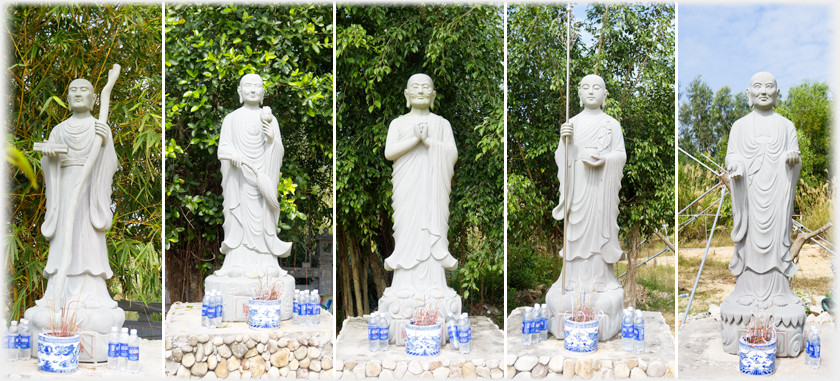 And here are the line of statues seen in the image just above to the right- nestled up a little here, their actual plinths are well separated. Each has a supply of water and a container of sand for you to plant your incense stick. This line is along one side of the square, they face across to a similar line of five statues
And here are the line of statues seen in the image just above to the right- nestled up a little here, their actual plinths are well separated. Each has a supply of water and a container of sand for you to plant your incense stick. This line is along one side of the square, they face across to a similar line of five statues
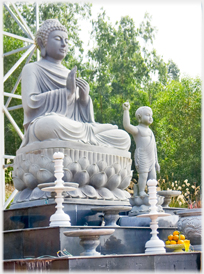 At the head of the square is this seated Buddha and a child with raised arm like the one two pictures down
At the head of the square is this seated Buddha and a child with raised arm like the one two pictures down
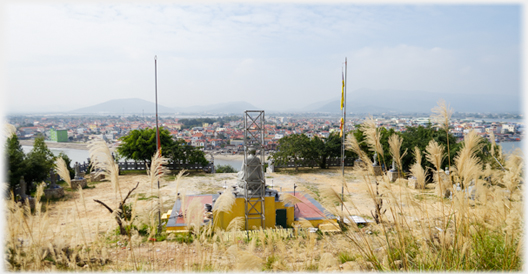 This picture is looking down on the square from higher up the hill, you may just be able to see the statues on the two sides. With the seated Buddha in the foreground looking towards the top of the steps and over to Hải Bỉnh across the river
This picture is looking down on the square from higher up the hill, you may just be able to see the statues on the two sides. With the seated Buddha in the foreground looking towards the top of the steps and over to Hải Bỉnh across the river
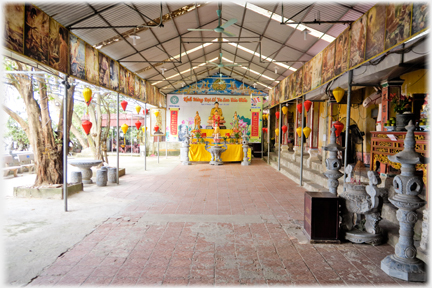 Returning down to the pagoda. The left of the courtyard...
Returning down to the pagoda. The left of the courtyard...
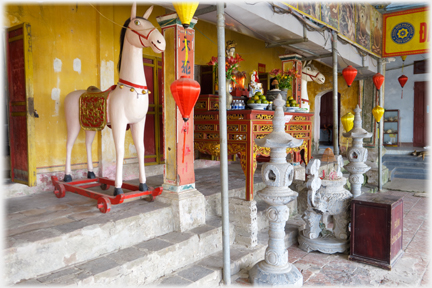 ...and the inner wall to the right of the courtyard area
...and the inner wall to the right of the courtyard area
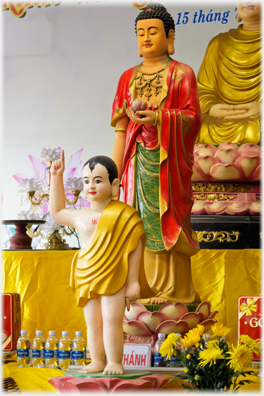 Two of the figures at the centre of the altar in the picture above
Two of the figures at the centre of the altar in the picture above
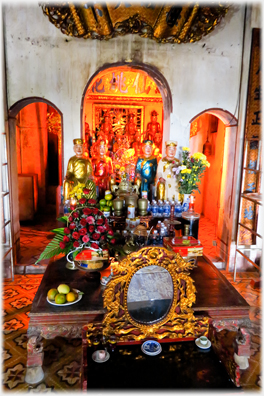 Looking into an inner shrine room, the mirror is in the next picture
Looking into an inner shrine room, the mirror is in the next picture
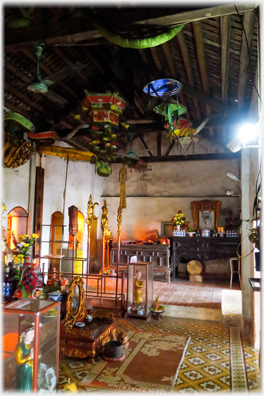 Looking across the outer shrine room, the mirror is now side on
Looking across the outer shrine room, the mirror is now side on
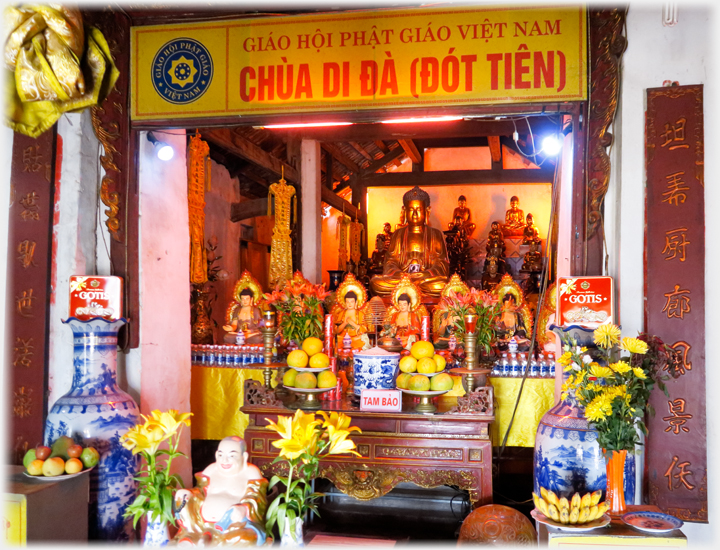 The small red sign by the fruit offerings (Tam Bảo) announces the Trinity of the three jewels, in which Buddhists of the Mahayana tradition take their refuge. The overhead sign says the pagoda, with its alternative name, is a member of the Vietnamese Buddhist Association. Chinese plaques like these are common in Vietnam, but they are mostly as intelligible to the average Vietnamese person as Latin inscriptions would be to us
The small red sign by the fruit offerings (Tam Bảo) announces the Trinity of the three jewels, in which Buddhists of the Mahayana tradition take their refuge. The overhead sign says the pagoda, with its alternative name, is a member of the Vietnamese Buddhist Association. Chinese plaques like these are common in Vietnam, but they are mostly as intelligible to the average Vietnamese person as Latin inscriptions would be to us
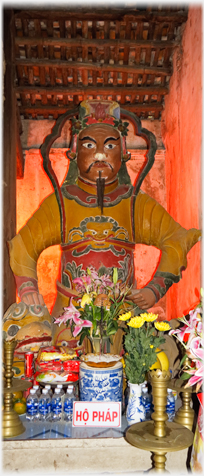
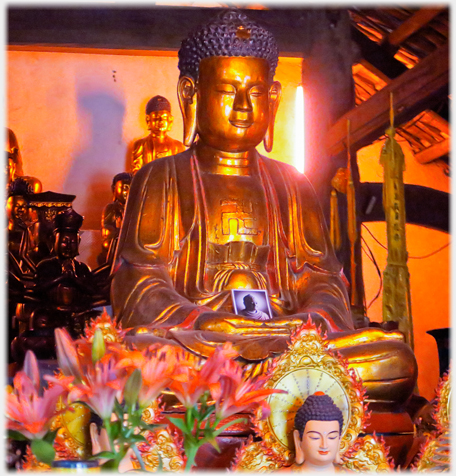 The central Buddha of the main shrine and in the two side shrines two 'Guardian' gods - as the notice informs us
The central Buddha of the main shrine and in the two side shrines two 'Guardian' gods - as the notice informs us
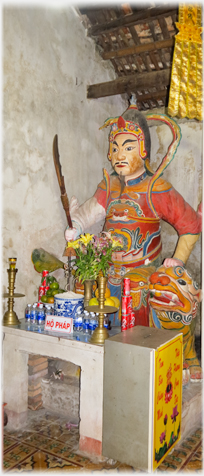
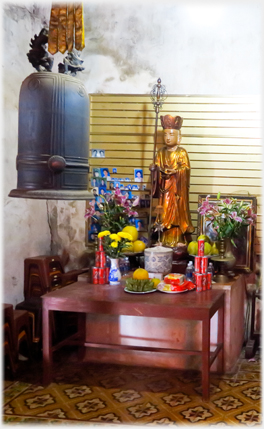 Bronze bell in side chapel
Bronze bell in side chapel
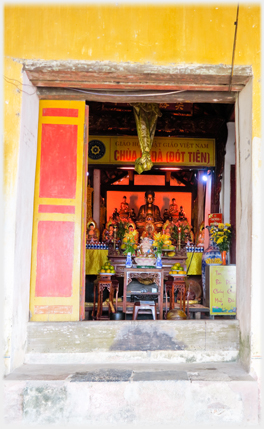 The view in from the courtyard...
The view in from the courtyard...
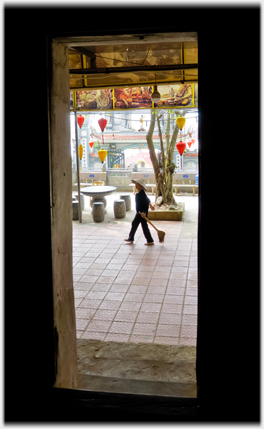 ...and the view out to the courtyard
...and the view out to the courtyard
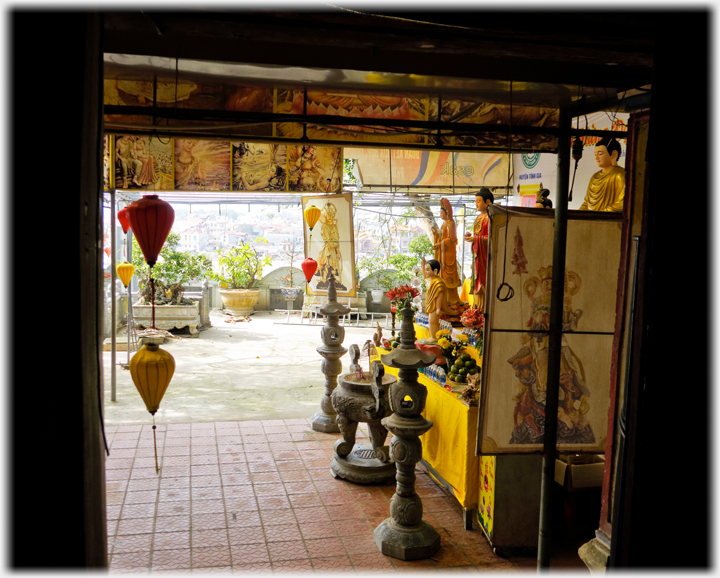 A view out of the main room past the altar on the courtyard, with the child figure seen in a picture above, and the town's houses beyond
Trailers...
A view out of the main room past the altar on the courtyard, with the child figure seen in a picture above, and the town's houses beyond
Trailers...
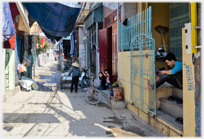 The next page of this section
takes you down from the Đót Tiên pagoda on the hill, to the tight lanes and passages of the town of Hải Thang below.
The next page of this section
takes you down from the Đót Tiên pagoda on the hill, to the tight lanes and passages of the town of Hải Thang below.
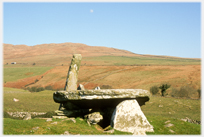 The next page
of the Mosaic Section is headed 'Finger Pointing to the Moon'.
The next page
of the Mosaic Section is headed 'Finger Pointing to the Moon'.
Or go to the contents of the Mosaic Section.

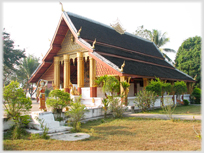 The last page showed pagodas in the Laos city of Luang Prabang
The last page showed pagodas in the Laos city of Luang Prabang
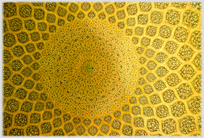 To a very different religious setting - Mosques of Isfahan
To a very different religious setting - Mosques of Isfahan
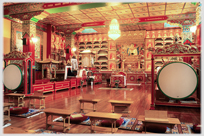 A Buddhist complex in southern Scotland
A Buddhist complex in southern Scotland
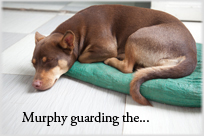 ...guide to this site
...guide to this site